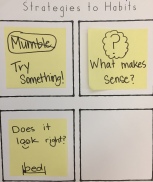Recently, I commented about removing the levels from my classroom library on a post from Irene C. Fountas and Guy Su Pinnell’s Facebook group. Their post was about using reading levels as a tool for teachers, not a tool for students. One teacher responded that giving children reading levels at least ensures they have books they can read. And I couldn’t agree more. That is exactly why many teachers use this practice in their classrooms. I did for years, knowing that if I assigned children levels from my diagnostic reading assessments I could assure they had books they could read. This works for many students. But for some kids, it doesn’t. Here are some potential situations readers find themselves in when assigned levels. These kids are the reason levels should not be a tool for students.
Setting unrealistic goals – “I want to read the highest level in the class because I want to be the best in the class.” But right now, that reader is reading below grade level and reaching that goals is not only unattainable, but it is also a hinderance to the work he needs to do.
Having an screwed reading identity – This happens in two ways. “I want to read level x books”instead of “I want to read more nonfiction or mystery books.” OR (and I’ve had this exact conversation) “What is wrong with my reading, why can’t I read level x?” When in fact the reader is above grade level, but not reading the highest level in the classroom.
Reading less challenging books – Readability is only one measure of text complexity and does not take into account the reader’s motivation, interest or background knowledge. Struggling readers will surprise you when they choose books just beyond their assessed levels and are motivated to read them.
So, how can reading teachers find a balance? Removing the scaffold of telling readers the levels they can read does not mean you leave them to read any book freely. It means you must replace that scaffold with other supports. Working with individual readers to set realistic and specific reading goals is one way to help them. Teaching strategies to work toward those goals means they must pick books they can read to practice the strategies. Here’s how I rolled it out with my first graders.
- Explicitly teach the options for reading goals. I use the Reading CAFE goal setting framework including Comprehension, Accuracy, Fluency or Expanding Vocabulary. Your students’ goals would match whatever reading benchmarks or goals you have in your curriculum. Heinemann shared a great goal setting sheet created by Jennifer Serrevallo. After sharing the goals, I ask students to think about what is tricky and decide what they would like to work on.
- Individually conference with each student to co-set a goal. This take some preplanning. After conducting reading assessments with my students I have a predetermined goal they each need to work on. Usually in our conference, my goal matches theirs. But when it doesn’t, I have two options.
- Ask why they want that goal. Recently, a six year told me she wanted to work on fluency while I thought she needed support in accuracy. Her rational was that another student told her she read smoothly, but with little expression. We went with her goal – she is motivated, has a clear focus, and fluency will also support her work in accuracy.
- Listen to the child read, notice something he is already doing with your goal in mind and lead him toward it. For example, a student who needs support in comprehension but is already making connections I name what he is doing and guide him toward the goal of comprehension. This identification of one thing he is already doing it attainable and authentic.
- Use visual tools to teach strategies to habits.
 I learned this in a workshop from Teachers College Reading and Writing Project. By recording the goal and teaching specific strategies to work toward that goal students are empowered in their own learning. Over time these strategies will become habits and we will co-create a new reading goal together. This is an example of strategies to support a student’s goal of reading accurately.
I learned this in a workshop from Teachers College Reading and Writing Project. By recording the goal and teaching specific strategies to work toward that goal students are empowered in their own learning. Over time these strategies will become habits and we will co-create a new reading goal together. This is an example of strategies to support a student’s goal of reading accurately.
Taking away reading levels does not equate to letting kids read whatever they want. Setting reading goals and purpose behind reading ensures students select books they can read. They know where they are headed and naturally begin to select books that are challenging, engaging and readable.

Love this for several reasons.
1. You are trying something new. Taking a risk to fill a problem you see.
2. This post helps me articulate clearly what I am doing with my reading groups. I let kids do their independent reading. I make observations, do DRA’s, and hold reading conferences. As I see areas for improvement, I create groups. Then I am able to say, “we are going to work on this element of reading.” Then I form new groups. Some kids need to be in a lot of groups. Other kids are able to apply ideas and strategies from the mini lessons.
LikeLiked by 1 person
[…] absent of reading levels. My students were unaware of their levels yet acutely tuned in to their reading goals and strategies to support those goals. I communicated their strengths and areas for growth with […]
LikeLike